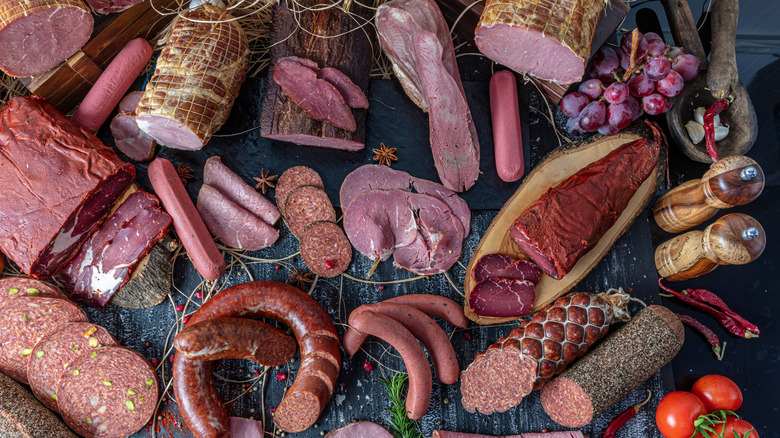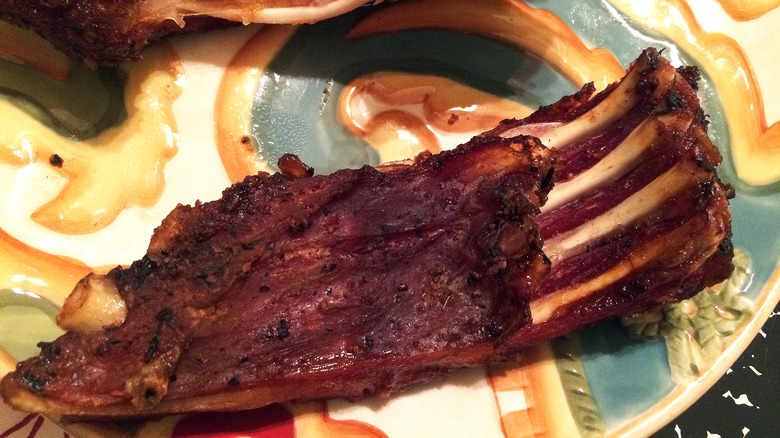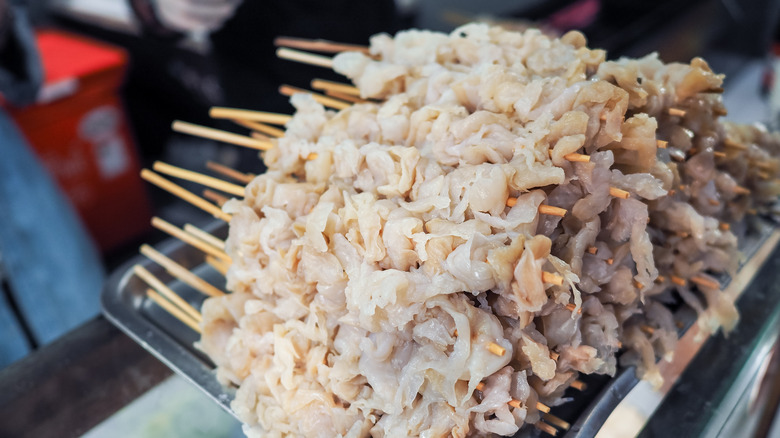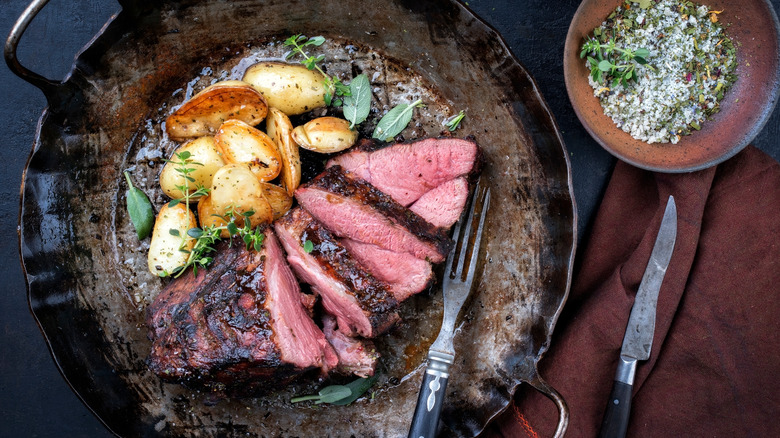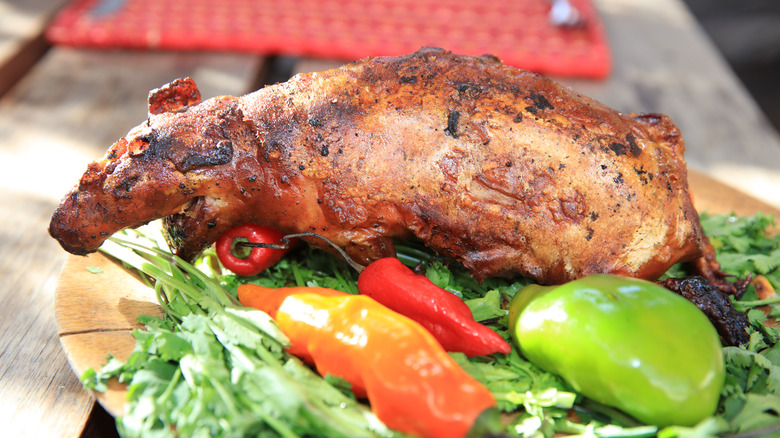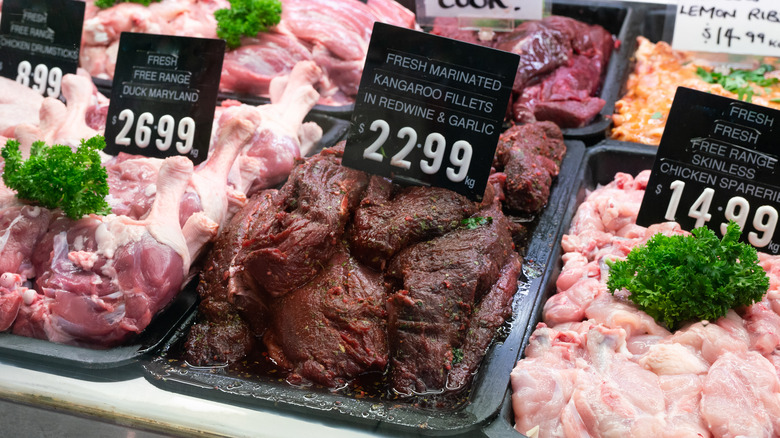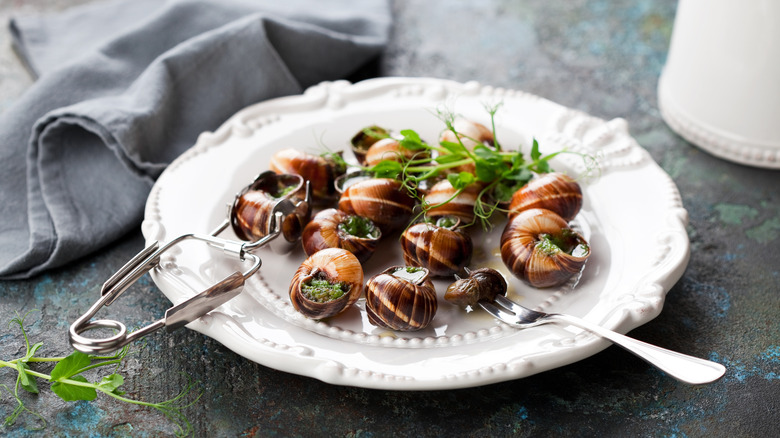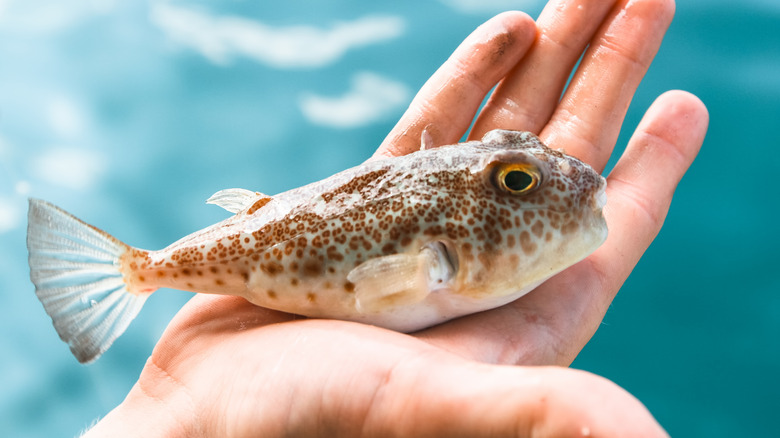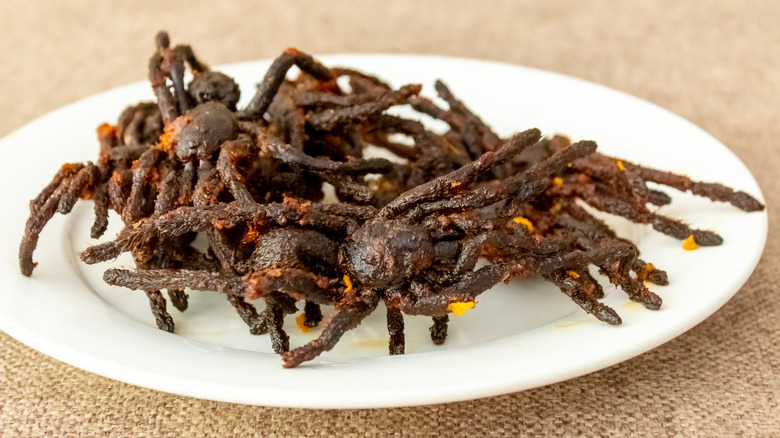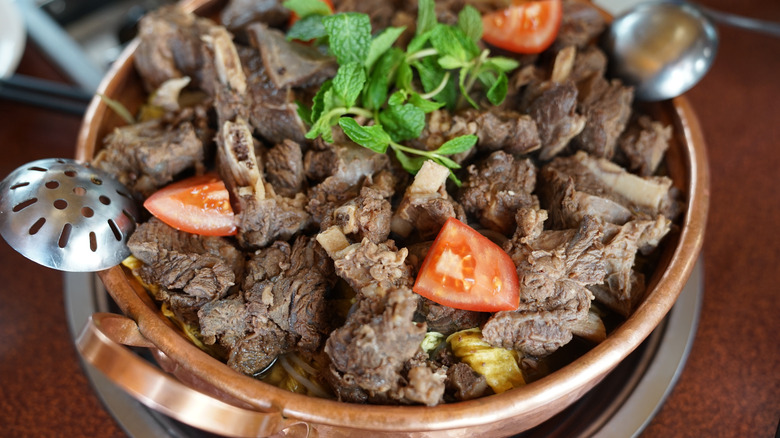Exotic Meats You Need To Try Before You Die
The world contains thousands of different animals, bugs, and fish. Sometimes it's amazing to think that our plates in the United States are limited to such a small number of them. If you stroll through the meat department of a typical grocery store, you'll find chicken, beef, pork, fish, and ... that's about it. It takes a trip to a specialty grocery store to find other options, and even those can be limited in the U.S.
If you're an adventurous eater, you shouldn't limit yourself to basic meat options like chicken and beef. There are many exotic types of meat enjoyed around the world, whether as a delicacy or in everyday meals. Trying different kinds of meats is a great way to learn about a culture and how they use their resources. It's also a great opportunity to expand your palate, embrace your adventurous side, and have a great story to tell later.
Some of these meats may surprise you with their flavor while others may limit you to a single tasting. Whether you enjoy them or not, here are some exotic meats every person should try before they die.
Alligator
Alligators are reptiles that are better known for being giant lizards with terrifying teeth. They're actually more closely related to dinosaurs than most animals on the Earth today. In fact, scientists believe that the American alligator species is more than 150 million years old! These reptiles can grow up to 15 feet long and weigh up to 1,000 pounds.
There are two species of alligators: the Chinese alligator and the American alligator. The former resides in Eastern China while the latter lives in the Southeastern United States, specifically in Florida and Louisiana and some parts of Georgia, Alabama, Mississippi, South and North Carolina, Texas, Oklahoma, and Arkansas.
People who live in the Southeastern United States have been enjoying gator for years. Some people hunt alligators for sport during a short legal hunting season while others buy their meat from alligator farms. If you want to try this meat, it's pretty easy to find in states like Florida and Louisiana. The taste is similar to dark meat chicken with a bit of fishiness. Barbecued ribs are particularly popular, but most parts of the animal can be cooked in various ways: stewed, braised, fried, or grilled. The nutritional facts aren't bad either: alligator is packed with protein and relatively low in fat and calories.
Jellyfish
Jellyfish are either viewed as soft, squishy sea creatures or terrifying monsters that will ruthlessly sting you if you aren't careful. Frankly, they have earned both reputations. There are around 200 different species of this animal around the world, ranging from harmless flame jellyfish to the deadly box jellyfish.
Although we're most used to seeing them in aquariums in the United States, people across Asia have been dining on these sea creatures for centuries. There are at least 11 species of jellyfish that are safe for humans to eat. It can be dried and eaten as a jerky or added to soups, salads, and noodle dishes. In contrast to its name, most jellyfish have a surprisingly crisp texture when eaten fresh.
The nutrient profile of this marine animal isn't as impressive as ostrich or elk, but it is a decent source of protein, antioxidants, and several minerals for a blob that floats around in the water for its entire life. Jellyfish are also argued as a sustainable food source that we need to take better advantage of. If you want to hunt down a bite of this sea creature, check the menus of your local Chinese, Japanese, or Thai restaurants. You can also find dried jellyfish in many Asian grocery stores.
Ostrich
These large flightless birds have been a staple in South Africa, their homeland, for hundreds of years. Recently, it's gained momentum in the United States as a more sustainable alternative to cattle and pig farms. "Ostrich emits virtually no methane, which is the most destructive greenhouse gas, and cows' burping and farting emit that," Alex McCoy, an ostrich farmer near Boise, Idaho, told Modern Farmer. "By incorporating ostrich into your diet, you're doing way more to fight the cause of global warming than driving your car less, flying less, or taking shorter showers."
Ostrich is extremely lean meat that tastes similar to beef. Like beef, it can be ground, made into sausage, or cut into steaks. Virtually any beef recipe can be substituted with ostrich meat. It's easiest to find frozen from a farm that ships their meat around the country or internationally. Because the meat is so lean and not widely available in the United States, it tends to be a bit pricey.
Rattlesnake
Staring at a rattlesnake doesn't exactly invoke feelings of hunger. You're probably thinking more about what would happen if those fangs got too close to your body. Rattlesnakes can be found all across North and South America but are especially common in the Southwestern United States. They get their name from the rattle at the end of their tail that creates a distinctive noise when they're warning predators to stay away. Rattlesnakes are venomous and while bites are rarely fatal, they will cause extreme pain and swelling until treated.
So why would anyone eat a rattlesnake? The first taste probably came down to survival — someone (looking at you, Bear Grylls) stranded in the desert could have killed a snake to protect themself from a bite and decided to grill up the meat. (If you ever find yourself in the position of needing to kill one of these snakes, the best thing to do is chop the head off and bury it. Due to a strange nervous system reflex, rattlesnakes can still bite you after they're dead!) The snake then needs to be skinned before you can grill the meat.
Many people say rattlesnake tastes similar to alligator — like a mixture of chicken and fish. Snakes have very little fat on their bodies, so the meat is tough and chewy. You can find rattlesnake in some restaurants in the American Southwest or online if you want to cook it yourself at home.
Wild Boar
Wild boar, or wild hogs, are a far cry from domesticated pigs we love to see on farms. These hybrid animals are often considered dangerous pests across North America. Wild boar are hearty, strong, and fast. They also love to destroy basically everything in their path and pass diseases along to other animals and humans.
Meat from wild boar was considered a delicacy for a long time because hunting them was a favorite pastime of royalty in Europe and Asia. Although wild boar hunting isn't as common today, their meat is still coveted because these animals live a truly free-range lifestyle. It's also difficult to access because of the strict rules in place to avoid the spread of disease. According to Smithsonian Magazine, "To be sold commercially as meat, wild hogs must be taken alive to one of nearly 100 statewide buying stations ... [They] are then taken to a buying station and from there to a processing plant overseen by U.S. Department of Agriculture inspectors." Most wild boars caught in the United States end up in Europe or Asia, so supply stays limited here.
Wild boar tastes similar to pork but has a sweeter, leaner flavor. It also has less fat, calories, and cholesterol than most pork raised in America. If you want to try this hog, seek out a restaurant that specializes in wild game.
Guinea Pig
If you've ever owned a pet guinea pig, you may want to skip this section. While these adorable creatures are kept as pets across the United States, they've been eaten in South America for years. About 65 million guinea pigs are eaten each year in Peru alone. It's practically a rite of passage to enjoy one of these rodents after hiking Machu Picchu or strolling around Lima.
As with many animals on this list, guinea pigs are gaining popularity as a meat source because of their smaller carbon footprint than beef, pork, and chicken. These rodents have a particularly strong argument for their consumption because they can be raised in your backyard, don't need a lot of food, and create little waste. If you're brave enough to give this exotic meat a try, be prepared for something that tastes like a cross between duck and rabbit. Roasted guinea pig is particularly flavorful and fatty, and just might have you change your mind about keeping these guys limited to pet stores.
Kangaroo
If you ever visit Australia, you may be surprised to see kangaroo meat offered alongside other cuts of meat in the deli. Kangaroo jerky in grocery stores, fresh kangaroo steaks in delis, and kangaroo burgers on restaurant menus are all common. Kangaroos in Australia are pretty similar to deer in the United States — you can find them everywhere.
But although this meat can be found all over the country, many Australians have a hard time swallowing it — literally. These marsupials used to make up a large part of the locals' diets but have become less popular in recent years. In addition to these marsupials being Australia's national symbol, popular media has portrayed them as too cute to eat.
That all being said, this exotic meat is gaining popularity again and is worth a try the next time you're down under. It's lean meat that is high in protein, but it tastes better than most gamey cuts. When cooked properly, it is quite flavorful and tender. It's also incredibly nutritious and better for the environment since all kangaroos are caught in the wild.
Elk
Elk is relatively common in parts of the United States where hunting is a popular practice. Some of the best states to hunt elk include Colorado, Oregon, Utah, and Idaho. Elk is different than venison, which is the meat that comes from deer. Venison is more common in the United States than elk meat but tastes gamier and more earthy.
Many fitness enthusiasts praise elk because it is high in protein while being relatively low in calories and fat. One 3.5 ounce serving of elk contains over 30 grams of protein. Per ounce, that is more protein than chicken or beef. This meat is also packed with vitamins and minerals, including iron, thiamine, riboflavin, zinc, and vitamin B12.
Elk comes in various cuts just like beef. Wild elk meat tastes gamier than farm-raised meat but is more expensive. You can find elk on the menu of restaurants specializing in game meat or online from farmers.
Escargot
A visit to France isn't complete without bread, cheese, and snails. Escargot (which is the French word for snail) is a delicacy for the French and you can find it on many menus around the country. And before you conjure up images of a slimy creature covered in mucus, you should know that escargot is not as crazy as it sounds. It has to taste good for the French to love it, after all.
In France, snails are traditionally served as an appetizer basted in garlic butter and parsley. They'll often be plated in a special dish that looks similar to a mini muffin pan, with each snail and shell getting its own spot in a cavity. When a snail is served to you in the shell, you will be given a tiny fork and a pair of oddly shaped tongs. The tongs allow you to grip onto the shell while you use the small fork to pull the snail meat from the shell.
Snails have a pretty mild flavor and a texture that is similar to mussels. If your escargot is cooked in garlic and butter, it will probably taste like garlic and butter. It's definitely a dish you don't want to miss on your next trip to France.
Fugu
We've all seen pufferfish, or fugu in Japanese, in aquariums so cute that we want to pinch their little cheeks. But they aren't so cute up close: pufferfish contain a toxin that can cause paralysis and even death when consumed. Something about a brush with death must be appealing because fugu is one of the most coveted food items in Japan. Chefs there spend years training for exclusive rights to prepare this delicacy. Restaurant guests who want to try it are required to sign special waivers before taking a bite.
Since the year 2000, over 20 people had died eating fugu. No one will laugh at you for deciding not to take this risk, but if you do it's important to only seek out pufferfish from reputable restaurants. This dish doesn't have much flavor and is usually accompanied by a sauce. When prepared correctly, it can be eaten raw or cooked.
Tarantula
Walking through a street market in Southeast Asia, you'll see a variety of roasted meats and tantalizing dishes in food stalls. Barbecued squid, beef kabobs, and ... tarantulas? In many parts of Asia, fried tarantulas are sold in street markets as a way to generate income when tourists pose for pictures while trying these hairy arachnids. However, tarantulas are considered a delicacy in Cambodia. In the 1970s, many Cambodians avoided starvation by learning to eat these spiders. Since then, tarantulas have been eaten as special treats by the locals.
Tarantulas are often deep-fried and coated in seasoning before being picked apart. The body is reportedly the best while the legs aren't as tasty. According to Culinary Lore, the best way to enjoy these arachnids is to start with the legs and eat them like you would enjoy crab legs. Detach them from the body of the spider and pull the meat out from those sections. There isn't much, but what you can get is apparently very tasty. After enjoying the legs, you can eat the head and the front portion of the body. Avoid the abdomen, as it is full of the spider's organs, eggs, and feces (yuck!). Although their bites contain venom, these spiders rarely cause fatalities in humans and are safe to eat. They are pretty easy to catch in the wild if you're brave enough to grab one from the ground or a tree branch.
Iguana
Iguanas are reptiles native to Mexico, Central America, South America, and the Caribbean. There are some 30 different species of iguana. They like to lounge in trees and soak up the sun because they're cold-blooded. Iguanas have also gained popularity recently as pets, although they can get quite large and aren't suited for most homes.
Similar to guinea pigs, it might sound unnatural to cut up an iguana and eat it, but these lizards make some pretty good meat. People in Central America have been eating iguana for years, and it's beginning to catch on in the United States. This meat is popular in South America and is making its way to North America as well. Iguanas are often called "chicken of the trees" because of the way they taste. In Florida, these reptiles have become an invasive species and it is legal to kill them in the state as long as it is done in a humane manner. They can be cooked any way chicken can.
Yak
Different from buffalo or bison, yaks are a bovine species native to the Tibetan Plateau. They look similar to domesticated cows in the United States but have longer, shaggier hair that allows them to survive the harsh winters of the Himalayas. They have been used as work animals and food for thousands of years by the locals who live in the mountains.
Yak meat is leaner than beef and the fight for this healthier protein alternative brought yaks to the states over 15 years ago. The animals themselves seem to be more environmentally friendly than cows as well. ”They only eat about a third of what a cow eats and can forage for food without damaging the environment,” Tom Worrell, who owns a yak farm in New Mexico, said. ”They have small hooves and are nimble, so they can move over rough mountainous terrain. They don't need much attention. Unlike cows, you don't have to get up in the middle of the night and calve them. They are pretty disease-resistant, so they don't need any hormones or antibiotics. And unlike bison, they are docile and easy to maintain.”
Although yak meat is lower in fat than beef, it has a richer flavor that makes up for the leanness. It can be cooked just like beef and added to virtually any dish. Or, to eat it traditionally, find a local Himalayan restaurant that serves momos (dumplings) with yak meat.
Eel
Sushi fans aren't phased by seeing eel on the menu, but it may catch you off guard if you aren't used to that type of cuisine. Eels, the slimy snakes of the sea, are a popular ingredient not only in Japan and China, but across Europe as well. Eel has a delicious fishy flavor. In Japan, it is known as unagi and added to sushi, rice dishes, stews, and curries. Eel meat soaks up the flavor of whatever it is cooked in and the texture is softer than many other seafood ingredients.
While eel is most commonly connected to Japan, it can be found in various forms elsewhere. Jellied eel, for example, is a cultural dish in England. In Italy, eel is roasted with minimal seasoning while Spain cooks it slowly into a rich and flavorful sauce.
One thing to keep in mind when you're hunting out this exotic meat is that unlike many types of seafood, eels cannot be eaten raw. Their blood is toxic to humans, so they must be thoroughly cooked before consumption. Once you've verified your eel is fully cooked, though, go ahead and enjoy this slimy sea creature.
